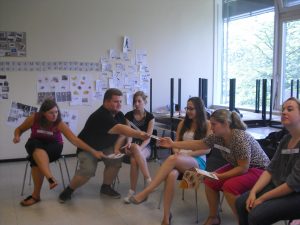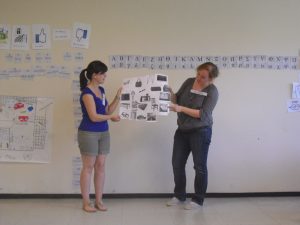Structuro-Global Audio-Visual (SGAV) methodology was developed in France in the 1960s (first generation) and 1970s (second generation).
Based on an eclectic holistic approach to second language acquisition, second-generation SGAV methodology emphasised the presentation of linguistic material in situation and the physical and affective participation of language learners in communicative interaction without the direct teaching of linguistic rules.
A SGAV method called All's Well was published in the mid-1970s and was widely used in France, particularly in continuing education programs, in the 1970s, but it gave way to communicative language teaching methods in the 1980s.
A brief Introduction to the Natural Approach (A Precursor to the Scaffolded Language Emergence Approach)
The Natural Approach was developed by Tracy Terrell and Stephen Krashen and was introduced in the book The Natural Approach in 1983. This method is based on observations of how children acquire their native language. It attempts to adapt this process of language acquisition to an adult learning environment. From this perspective, it is necessary to emphasize the importance of communicative skills instead of focusing on grammar-based language learning. This method highlights comprehensible and meaningful practice activities and introduces the language learner to a great deal of vocabulary at the beginning rather than the production of grammatically perfect sentences. Basic rules for implementing this method include not using the learners' native language and not referring to grammatical explanations. The language is viewed as a vehicle for communicating meanings and messages.
This approach is just one of several approaches that underlie Dr. Donald Kiraly's Scaffolded Language Emergence approach.
You can find further information on the Natural Approach here:
The Natural Approach (Video)
The Natural Approach: Language Acquisition in the Classroom (by Steven D. Krashen & Tracy D. Terrell)
The Second Language Acquisition (SLA) process presented on this page rejects the view of language teaching as an instructional practice as well as the view of teachers as distributors of knowledge. Instead, this perspective suggests that learners should be integrated actively in the learning and teaching process and that they should collaborate with the teacher to create learning opportunities. Behind this is the idea that learners need to create their 'own' language, they need to establish a connection. Language –and meaning –here is not seen as something to be mastered through the study of grammar but through interactions with others in the foreign tongue, through communication. The following suggestions illustrate what can be done in a language teaching course to create a dynamic, active, and communicative forum for language acquisition.
 Language learning is not a linear process with a beginning and an end but rather a life-long process, always emerging and not fully controllable. This is why teachers should not try to control the natural process of language acquisition but rather integrate learners and explore the world around them (e.g. through games, study trips, cooking, etc) through the medium of the foreign language.
Language learning is not a linear process with a beginning and an end but rather a life-long process, always emerging and not fully controllable. This is why teachers should not try to control the natural process of language acquisition but rather integrate learners and explore the world around them (e.g. through games, study trips, cooking, etc) through the medium of the foreign language.
This approach to SLA also aims to include both mind and body – as they are seen as a unity rather than a duality. Exercises involving the whole body are recommended, such as acting out one's feelings and gestures in the group. With exercises like this, learners improve their understanding and communicative skills on two levels: physical and mental.
 As already mentioned in the introduction above, everyday situations can help to establish a connection to a foreign language. Possible topics could be shopping, cooking meals from the culture where the language is spoken -- and enjoying the meal together! There is always the option for students to come up with additional topics they find interesting.
As already mentioned in the introduction above, everyday situations can help to establish a connection to a foreign language. Possible topics could be shopping, cooking meals from the culture where the language is spoken -- and enjoying the meal together! There is always the option for students to come up with additional topics they find interesting.
NOTE: For Videos of the FTSK Language Learning Courses visit the "Examples" sub-page.
At the FTSK, we tried to design intensive scaffolded language emergence courses and seminars for students. The intensive language courses should promote and demand a holistic learning of foreign languages for students, whereas the seminars were to be in the area of foreign language didactics. Students get the chance to take part in research projects and extend their skills as prospective language teachers and mediatiors.
The intensive language development courses comprise approximately 50-75 contact hours and are operated by teams of students, who will later also represent the course facilitators. The structure, content and learn activities of these courses are usually not prefabricated in form of a method, but are individually designed by the facilitators for each group.
1) Intensive Spanish Course for Beginners
The project began with a Spanish intensive course, which was offered by the department of English Linguistics and Translation Studies in cooperation with the language centre of the faculty in Germersheim in October 2011. This course was developed for participants without previous knowledge of the Spanish language and was directed at students of other languages in Germersheim.
One week ahead of the course, a one-day workshop was held, where the students learned about the main features of the Natural Approach and the Second Language Emergence in the Classroom method.
2) Research Oriented Seminar in Foreign Language Didactic: Processing of Data of the Vivid Spanish Course
22 students participated in the seminar, which was part of the Foreign Language module in the summer semester 2012 at the faculty in Germersheim. The students had the chance to get an insight in foreign language didactics and learning processes by practicing largely autonomous research work in teams. The students were given the following tasks:
- working collaborative with the lecturer (Dr. Donald Kiraly) to look into the collected data of the previous Spanish course
- analysing and searching for indicators of learning processes in the data
A selection of background reading of diverse studies concerning second language acquisition was given to the participants.
Footage of various language courses at the FTSK:
Spanish Course FTSK
Hungarian Course FTSK
Portuguese Course FTSK
Dutch Course FTSK

